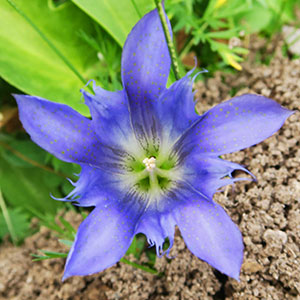Gentiana newberryi
Gentiana clausa
alpine gentian, Newberry's gentian
bottle gentian, closed gentian, gentiane close, meadow bottle gentian
1–5, arising laterally below rosettes, from a stout tap root, tufted, decumbent.
1–10, terminal from caudex, erect or decumbent.
basal and cauline;
blades of basal rosette and proximal cauline leaf blades widely spatulate to obovate or oblanceolate, 0.8–5 cm × 2–25 mm, apex obtuse or mucronate, at least these leaves with blades less than 6 times as long as wide, distal cauline leaves few, with blades oblanceolate to lanceolate or linear, 2–5 cm × 2–5 mm, apices acute.
cauline, ± evenly spaced;
blade ovate, 3–15 cm × 10–45 mm, apex acuminate.
terminal, flowers usually solitary, occasionally 2 or 3.
1–20-flowered heads, sometimes with additional flowers at 1–3 nodes, rarely on short branches.
calyx 14–30 mm, lobes linear to narrowly ovate, (4–)6–12 mm, margins not ciliate;
corolla white or blue, campanulate, open, 23–55 mm, lobes spreading, elliptic-obovate, 7–17 mm, free portions of plicae divided into 2 triangular, serrate to lacerate segments;
anthers distinct.
calyx 8–22 mm, lobes spreading nearly horizontally, widely obovate or elliptic to orbiculate, 2–6(–10) mm, margins ciliate;
corolla blue or occasionally violet or white, tubular, completely closed, 23–40 mm, lobes incurved, ovate-triangular to semicircular, 0.7–2 mm, free portions of plicae ± as long and as wide as lobes, oblong, deeply and unequally bifid, summit erose;
anthers connate.
winged.
winged.
= 26.
Gentiana newberryi
Gentiana clausa
Varieties 2 (2 in the flora).
The two varieties of Gentiana newberryi intergrade extensively. The most distinctive form of var. newberryi, with relatively tall stems and medium to deep blue corollas, occurs in the northern part of the range of the species, from the Klamath and White mountains of California north into Oregon. Plants most clearly referable to var. tiogana prevail in the southern part of the range of the species, from Butte County south to Inyo and Tulare counties, California. In the central part of the range of the species, plant size and corolla color are less consistently correlated, with occasional plants combining low stature with deep blue corollas or tall stems with predominantly white or pale blue corollas. In that part of the range, corolla color may be highly variable within a single population.
The leaves of Gentiana newberryi are thick-textured and distinctively concave, usually spoon-shaped, when fresh. Narrower leaves sometimes occur in var. tiogana, but many plants of that variety have widely spatulate leaves like those of var. newberryi.
(Discussion copyrighted by Flora of North America; reprinted with permission.)
The corollas of Gentiana andrewsii, G. austromontana, and G. clausa all remain completely and tightly closed but are pollinated by bumblebees, which force open the corollas. The fresh corollas of G. clausa are rounded at the summit, with the plicae concealed by the true lobes. In contrast, the fresh corollas of G. andrewsii and G. austromontana are more acute, with the plicae forming much or all of the visible summit. The corolla lobes of G. clausa are about as long and as wide as the free portions of the plicae, whereas those of G. andrewsii and G. austromontana are distinctly narrower than the plicae. Also, in contrast to those of other species of Gentiana in the flora area except for G. flavida and G. latidens, the calyx lobes of G. clausa when fresh spread almost horizontally rather than being nearly erect.
Reports of Gentiana clausa from Indiana to Missouri and elsewhere west of the range given here have been based on specimens of G. andrewsii var. dakotica, second- or later-generation plants derived from G. andrewsii × G. puberulenta, or other hybrids and introgressants. In these plants, in contrast to G. clausa, the sepals are lanceolate and nearly erect, and the lobes of the intact corolla do not entirely conceal the plicae.
Gentiana clausa is largely isolated ecologically and geographically, but a few hybrids with G. andrewsii, G. austromontana, G. decora, and G. saponaria are known.
(Discussion copyrighted by Flora of North America; reprinted with permission.)
1. Corollas medium to deep blue with greenish to dark purple lines abaxially on and below lobes, usually 35–55 mm. | var. newberryi |
1. Corollas white to pale blue except for greenish to dark purple lines abaxially on and below lobes, usually 23–42 mm. | var. tiogana |


